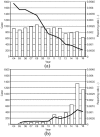Adverse event profiles of solvent-based and nanoparticle albumin-bound paclitaxel formulations using the Food and Drug Administration Adverse Event Reporting System
- PMID: 30886713
- PMCID: PMC6413422
- DOI: 10.1177/2050312119836011
Adverse event profiles of solvent-based and nanoparticle albumin-bound paclitaxel formulations using the Food and Drug Administration Adverse Event Reporting System
Abstract
Objectives: Paclitaxel is a highly effective antitumor agent with notable adverse events, including hypersensitivity reactions, peripheral neuropathy, arthralgia, myalgias, and neutropenia. Solvent-based paclitaxel causes severe allergic, hypersensitivity, and anaphylactic reactions. Nanoparticle albumin-bound paclitaxel was recently developed and provides an advantage over solvent-based paclitaxel in avoiding solvent/surfactant-related adverse events. The aim of this study was to assess the adverse event profiles of solvent-based paclitaxel and nanoparticle albumin-bound paclitaxel formulations using data from the spontaneous adverse event reporting system of the US Food and Drug Administration Adverse Event Reporting System database.
Methods: This study relied on Medical Dictionary for Regulatory Activities preferred terms and standardized queries, and calculated the reporting ratio and reporting odds ratios of paclitaxel formulations.
Results: Of 8,867,135 reports recorded in the US Food and Drug Administration Adverse Event Reporting System database from January 2004 to December 2016, 3469 and 4447 adverse events corresponded to solvent-based paclitaxel and nanoparticle albumin-bound paclitaxel, respectively. Reporting odds ratios (95% confidence interval) for anaphylactic reaction (standardized MedDRA query code: 20000021) associated with the use of solvent-based paclitaxel and nanoparticle albumin-bound paclitaxel were 1.69 (1.56-1.84) and 0.75 (0.68-0.83), respectively. Reporting odds ratio signal for anaphylactic reaction was not detected for nanoparticle albumin-bound paclitaxel. Reporting odds ratios (95% confidence interval) for acute renal failure (standardized MedDRA query code: 20000003) associated with the use of solvent-based paclitaxel and nanoparticle albumin-bound paclitaxel were 0.75 (0.58-0.98) and 1.60 (1.37-1.89), respectively.
Conclusion: This is the first study to evaluate the adverse event profile of nanoparticle albumin-bound paclitaxel using US Food and Drug Administration Adverse Event Reporting System data. Considering that the US Food and Drug Administration Adverse Event Reporting System database does not allow to infer causality or risk ranking, the different reporting frequencies of anaphylactic reaction and acute renal failure between solvent-based paclitaxel and nanoparticle albumin-bound paclitaxel must be further investigated via analytical observational research.
Keywords: Abraxane; Food and Drug Administration Adverse Event Reporting System; Paclitaxel; Taxol.
Conflict of interest statement
Declaration of conflicting interests: The author(s) declared no potential conflicts of interest with respect to the research, authorship, and/or publication of this article.
Figures
Similar articles
-
Safety signals of albumin-bound paclitaxel: Data mining of the Food and Drug Administration adverse event reporting system.Indian J Pharmacol. 2023 May-Jun;55(3):167-173. doi: 10.4103/ijp.ijp_640_22. Indian J Pharmacol. 2023. PMID: 37555411 Free PMC article.
-
Data mining for signal detection of adverse events for taxanes based on the food and drug administration adverse drug events reporting system database.Expert Opin Drug Saf. 2023 Jul-Dec;22(9):833-839. doi: 10.1080/14740338.2023.2203487. Epub 2023 Apr 17. Expert Opin Drug Saf. 2023. PMID: 37055919
-
Comparison of the adverse event profiles of conventional and liposomal formulations of doxorubicin using the FDA adverse event reporting system.PLoS One. 2017 Sep 27;12(9):e0185654. doi: 10.1371/journal.pone.0185654. eCollection 2017. PLoS One. 2017. PMID: 28953936 Free PMC article.
-
Albumin-bound paclitaxel: a next-generation taxane.Expert Opin Pharmacother. 2006 Jun;7(8):1041-53. doi: 10.1517/14656566.7.8.1041. Expert Opin Pharmacother. 2006. PMID: 16722814 Review.
-
Protein nanoparticles as drug carriers in clinical medicine.Adv Drug Deliv Rev. 2008 May 22;60(8):876-85. doi: 10.1016/j.addr.2007.08.044. Epub 2008 Feb 7. Adv Drug Deliv Rev. 2008. PMID: 18423779 Review.
Cited by
-
Cell metabolomics analyses revealed a role of altered fatty acid oxidation in neurotoxicity pattern difference between nab-paclitaxel and solvent-based paclitaxel.PLoS One. 2021 Mar 19;16(3):e0248942. doi: 10.1371/journal.pone.0248942. eCollection 2021. PLoS One. 2021. PMID: 33740022 Free PMC article.
-
Analysis of chemotherapy-induced peripheral neuropathy using the Japanese Adverse Drug Event Report database.Sci Rep. 2021 May 31;11(1):11324. doi: 10.1038/s41598-021-90848-6. Sci Rep. 2021. PMID: 34059747 Free PMC article.
-
Nab-paclitaxel plus S-1 versus oxaliplatin plus S-1 as first-line treatment in advanced gastric cancer: results of a multicenter, randomized, phase III trial (GAPSO study).Ther Adv Med Oncol. 2022 Aug 12;14:17588359221118020. doi: 10.1177/17588359221118020. eCollection 2022. Ther Adv Med Oncol. 2022. PMID: 35983025 Free PMC article.
-
Chemotherapeutic properties and side-effects associated with the clinical practice of terpene alkaloids: paclitaxel, docetaxel, and cabazitaxel.Front Pharmacol. 2023 May 9;14:1157306. doi: 10.3389/fphar.2023.1157306. eCollection 2023. Front Pharmacol. 2023. PMID: 37229270 Free PMC article. Review.
-
Preclinical Development of a Genetically Engineered Albumin-Binding Nanoparticle of Paclitaxel.Small Sci. 2024 Sep 25;4(11):2400153. doi: 10.1002/smsc.202400153. eCollection 2024 Nov. Small Sci. 2024. PMID: 40213453 Free PMC article.
References
-
- Wani MC, Taylor HL, Wall ME, et al. Plant antitumor agents. VI. Isolation and structure of taxol, a novel antileukemic and antitumor agent from Taxus brevifolia. J Am Chem Soc 1971; 93: 2325–2327. - PubMed
-
- Rowinsky EK, Donehower RC. Paclitaxel (taxol). N Engl J Med 1995; 332: 1004–1014. - PubMed
-
- Crown J, O’Leary M. The taxanes: an update. Lancet 2000; 355: 1176–1178. - PubMed
-
- Socinski MA. Single-agent paclitaxel in the treatment of advanced non-small cell lung cancer. Oncologist 1999; 4: 408–416. - PubMed
-
- Hawkins MJ, Soon-Shiong P, Desai N. Protein nanoparticles as drug carriers in clinical medicine. Adv Drug Deliv Rev 2008; 60(8): 876–885. - PubMed
LinkOut - more resources
Full Text Sources


